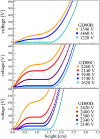Characterization of 30 Ge enriched Broad Energy Ge detectors for GERDA Phase II
- PMID: 31885491
- PMCID: PMC6892349
- DOI: 10.1140/epjc/s10052-019-7353-8
Characterization of 30 Ge enriched Broad Energy Ge detectors for GERDA Phase II
Abstract
The GERmanium Detector Array (Gerda) is a low background experiment located at the Laboratori Nazionali del Gran Sasso in Italy, which searches for neutrinoless double-beta decay of Ge into Se+2e . Gerda has been conceived in two phases. Phase II, which started in December 2015, features several novelties including 30 new 76Ge enriched detectors. These were manufactured according to the Broad Energy Germanium (BEGe) detector design that has a better background discrimination capability and energy resolution compared to formerly widely-used types. Prior to their installation, the new BEGe detectors were mounted in vacuum cryostats and characterized in detail in the Hades underground laboratory in Belgium. This paper describes the properties and the overall performance of these detectors during operation in vacuum. The characterization campaign provided not only direct input for Gerda Phase II data collection and analyses, but also allowed to study detector phenomena, detector correlations as well as to test the accuracy of pulse shape simulation codes.
© The Author(s) 2019.
Figures
















References
-
- Fiorini E, et al. Phys. Lett. B. 1967;25:602–603. doi: 10.1016/0370-2693(67)90127-X. - DOI
-
- Aalseth CE, et al. Phys. Rev. D. 2002;65:092007. doi: 10.1103/PhysRevD.65.092007. - DOI
-
- Klapdor-Kleingrothaus HV, Krivosheina IV. Mod. Phys. Lett. A. 2006;21:1547. doi: 10.1142/S0217732306020937. - DOI
-
- I. Abt et al. (Gerda collaboration), Gerda: The GERmanium Detector Array for the search of neutrinoless decays of Ge at LNGS, Letter of Intent to LNGS, Proposal to LNGS 38/04 (2004). http://www.mpi-hd.mpg.de/gerda/. arXiv:hep-ex/0404039v1
-
- K.-H. Ackermann et al. (Gerda collaboration), Eur. Phys. J. C 73, 2330 (2013)
